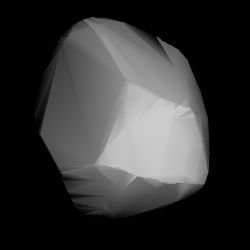217 Eudora
 3D model based on lightcurve data | |
| Discovery | |
|---|---|
| Discovered by | J. Coggia |
| Discovery date | 30 August 1880 |
| Designations | |
| (217) Eudora | |
| Pronunciation | /juːˈdɔːrə/[1] |
Named after | Eudora |
| A880 QA, 1914 RA | |
| Main belt | |
| Orbital characteristics[2] | |
| Epoch 31 July 2016 (JD 2457600.5) | |
| Uncertainty parameter 0 | |
| Observation arc | 130.48 yr (47657 d) |
| Aphelion | 3.75541 AU (561.801 Gm) |
| Perihelion | 1.98080 AU (296.323 Gm) |
| 2.86811 AU (429.063 Gm) | |
| Eccentricity | 0.30937 |
| 4.86 yr (1774.2 d) | |
Average orbital speed | 17.57 km/s |
| 349.290° | |
| 0° 12m 10.49s / day | |
| Inclination | 10.5165° |
| 162.594° | |
| 155.320° | |
| Physical characteristics | |
| Dimensions | 66.24±2.3 km[2] 68.62 ± 1.41 km[3] |
| Mass | (1.52 ± 0.06) × 1018 kg[3] |
Mean density | 8.98 ± 0.65 g/cm3[3] |
| 25.272 h (1.0530 d)[2] 25.253 ± 0.003 hr[4] | |
| 0.0484±0.004 | |
| C | |
| 9.80 | |
Eudora (minor planet designation: 217 Eudora) is a large Main belt asteroid. It was discovered by French (Corsican) astronomer J. Coggia on August 30, 1880, in Marseilles, France. It was his fourth asteroid discovery and is named after Eudora, a Hyad in Greek mythology.
It probably has a composition similar to carbonaceous chondrites. In 2007, a study showed it rotates every 25.253 ± 0.003 hours, based on lightcurve data.[4] A light curve generated from photometric observations at Pulkovo Observatory, give a matching rotation period of 25.253 ± 0.002 hours and a brightness variation of 0.22 ± 0.04 in magnitude.[5]
See also[edit]
References[edit]
- ^ Noah Webster (1884) A Practical Dictionary of the English Language
- ^ a b c "217 Eudora". JPL Small-Body Database. NASA/Jet Propulsion Laboratory. Retrieved 12 May 2016.
- ^ a b c Carry, B. (December 2012), "Density of asteroids", Planetary and Space Science, vol. 73, pp. 98–118, arXiv:1203.4336, Bibcode:2012P&SS...73...98C, doi:10.1016/j.pss.2012.03.009. See Table 1.
- ^ a b Buchheim, Robert K. (March 2007), "Lightcurves for 122 Gerda, 217 Eudora, 631 Phillipina, 670 Ottegebe, and 972 Cohnia", The Minor Planet Bulletin, vol. 34, no. 1, pp. 113–14, Bibcode:2007MPBu...34...13B.
- ^ Pilcher, Frederick (October 2011), "Rotation Period Determinations for 11 Parthenope, 38 Leda, 111 Ate 194 Prokne, 217 Eudora, and 224 Oceana", The Minor Planet Bulletin, vol. 38, no. 4, pp. 183–185, Bibcode:2011MPBu...38..183P.
External links[edit]
- The Asteroid Orbital Elements Database
- Minor Planet Discovery Circumstances
- Asteroid Lightcurve Data File
- 217 Eudora at AstDyS-2, Asteroids—Dynamic Site
- 217 Eudora at the JPL Small-Body Database
